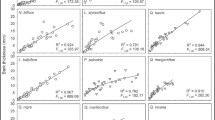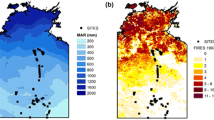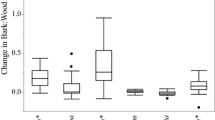Abstract
Although produced by meristems that are continuous along the stem length, marked differences in bark morphology and in microenvironment would suggest that main stem and twig bark might differ ecologically. Here, we examined: (1) how closely associated main stem and twig bark traits were, (2) how these associations varied across sites, and (3) used these associations to infer functional and ecological differences between twig and main stem bark. We measured density, water content, photosynthesis presence/absence, total, outer, inner, and relative thicknesses of main stem and twig bark from 85 species of angiosperms from six sites of contrasting precipitation, temperature, and fire regimes. Density and water content did not differ between main stems and twigs across species and sites. Species with thicker twig bark had disproportionately thicker main stem bark in most sites, but the slope and degree of association varied. Disproportionately thicker main stem bark for a given twig bark thickness in most fire-prone sites suggested stem protection near the ground. The savanna had the opposite trend, suggesting that selection also favors twig protection in these fire-prone habitats. A weak main stem-twig bark thickness association was observed in non fire-prone sites. The near-ubiquity of photosynthesis in twigs highlighted its likely ecological importance; variation in this activity was predicted by outer bark thickness in main stems. It seems that the ecology of twig bark can be generalized to main stem bark, but not for functions depending on the amount of bark, such as protection, storage, or photosynthesis.




Similar content being viewed by others
References
Butler DW, Gleason SM, Westoby M (2012) Setbacks to shoot growth are common in woody plants, so how are shoots of some species safer than others? Ecology 93:1275–1282. doi:10.1890/11-1017.1
Carlquist S (1982) The use of ethylendiamine in softening hard plant structures for paraffin sectioning. Stain Technol 57:311–317
Cernusak LA, Hutley LB (2011) Stable isotopes reveal the contribution of corticular photosynthesis to growth in branches of Eucalyptus miniata. Plant Physiol 155:515–523. doi:10.1104/pp.110.163337
Cernusak LA, Hutley LB, Beringer J, Tapper NJ (2006) Stem and leaf gas exchange and their responses to fire in a north Australian tropical savanna. Plant Cell Environ 29:632–646. doi:10.1111/j.1365-3040.2005.01442.x
Chave J, Coomes D, Jansen S, Lewis SL, Swenson NG, Zanne AE (2009) Towards a worldwide wood economics spectrum. Ecol Lett 12:351–366. doi:10.1111/j.1461-0248.2009.01285.x
Clarke PJ, et al. (2013) Resprouting as a key functional trait: how buds, protection and resources drive persistence after fire. New Phytol 197:19–35. doi:10.1111/nph.12001
Dantas VDL, Pausas JG (2013) The lanky and the corky: fire-escape strategies in savanna woody species. J Ecol 101:2454–2463
Domec JC, Gartner BL (2002) How do water transport and water storage differ in coniferous earlywood and latewood? J Exp Bot 53:2369–2379. doi:10.1093/Jxb/Erf100
Evert RF, Eichhorn SE (2006) Esau’s plant anatomy: meristems, cells, and tissues of the plant body: their structure, function, and development. Wiley, Hoboken
Felsenstein J (1985) Phylogenies and the comparative method. Am Nat 125:1–15
Franco-Vizcaíno E, Goldstein G, Ting IP (1990) Comparative gas exchange of leaves and bark in three stem succulents of Baja California. Am J Bot 77:1272–1278
Gibson AC (1983) Anatomy of photosynthetic old stems of non succulent dicotyledons from North American deserts. Bot Gaz 144:347–362
Graves SJ, Rifai SW, Putz FE (2014) Outer bark thickness decreases more with height on stems of fire-resistant than fire-sensitive Floridian oaks (Quercus spp.; Fagaceae). Am J Bot 101:2183–2188. doi:10.3732/ajb.1400412
Hoffmann WA, Solbrig OT (2003) The role of top kill in the differential response of savanna woody species to fire. For Ecol Manage 180:273–286. doi:10.1016/s0378-1127(02)00566-2
Junikka L (1994) Survey of English macroscopic bark terminology. IAWA J 15:3–45
Kleinbaum DG, Klein M (2010) Logistic regression. A self-learning text. Springer, New York
Kohl M (2012) MKmisc: miscellaneous functions from M Kohl. R package version 0.91
Lawes MJ, Richards A, Dathe J, Midgley JJ (2011) Bark thickness determines fire resistance of selected tree species from fire-prone tropical savanna in north Australia. Plant Ecol 212:2057–2069. doi:10.1007/s11258-011-9954-7
Midgley JJ, Lawes MJ, Chamaille-Jammes S (2010) Savanna woody plant dynamics: the role of fire and herbivory, separately and synergistically. Aust J Bot 58:1–11. doi:10.1071/bt09034
Murphy BP, et al. (2013) Fire regimes of Australia: a pyrogeographic model system. J Biogeogr 40:1048–1058. doi:10.1111/jbi.12065
Niklas KJ (1999) The mechanical role of bark. Am J Bot 86:465–469. doi:10.2307/2656806
Paine CET, Stahl C, Courtois EA, Patiño S, Sarmiento C, Baraloto C (2010) Functional explanations for variation in bark thickness in tropical rain forest trees. Funct Ecol 24:1202–1210. doi:10.1111/j.1365-2435.2010.01736.x
Paradis E, Claude J, Strimmer K (2004) APE: analyses of phylogenetics and evolution in R language. Bioinformatics 20:289–290. doi:10.1093/Bioinformatics/Btg412
Patiño S, et al. (2009) Branch xylem density variations across the Amazon Basin. Biogeosciences 6:545–568. doi:10.5194/bg-6-545-2009
Pausas JG (2014) Bark thickness and fire regime. Funct Ecol. doi:10.1111/1365-2435.12372
Pfanz H (2008) Bark photosynthesis. Trees Struct Funct 22:137–138. doi:10.1007/s00468-007-0196-1
Pfanz H, Aschan G, Langenfeld-Heyser R, Wittmann C, Loose M (2002) Ecology and ecophysiology of tree stems: corticular and wood photosynthesis. Naturwissenschaften 89:147–162. doi:10.1007/s00114-002-0309-z
Pinard MA, Lutz FE, Licona JC (1999) Tree mortality and vine proliferation following a wildfire in a subhumid tropical forest in eastern Bolivia. For Ecol Manage 116:247–252. doi:10.1016/s0378-1127(98)00447-2
Poorter L, McNeil A, Hurtado VH, Prins H, Putz J (2014) Bark traits and life history strategies of tropical dry and moist forest trees. Funct Ecol 28:232–242. doi:10.1111/1365-2435.12158
R Development Core Team (2013) R: A language and environment for statistical computing, v. 3.0.2 edn. R Foundation for Statistical Computing, Vienna
Reich PB (2014) The world-wide ‘fast–slow’ plant economics spectrum: a traits manifesto. J Ecol 102:275–301. doi:10.1111/1365-2745.12211
Romero C (2013) Bark structure and functional ecology. In: Cunningham AB, Campbell BM, Luckert MK (eds) Bark: use, management, and commerce in Africa, vol 17. The New York Botanical Garden Press, New York, pp 5–25
Romero C, Bolker BM, Edwards CE (2009) Stem responses to damage: the evolutionary ecology of Quercus species in contrasting fire regimes. New Phytol 182:261–271. doi:10.1111/j.1469-8137.2008.02733.x
Rosell JA, Olson ME (2014) The evolution of bark mechanics and storage across habitats in a clade of tropical trees. Am J Bot 101:764–777
Rosell JA, Olson ME, Aguirre-Hernández R, Carlquist S (2007) Logistic regression in comparative wood anatomy: tracheid types, wood anatomical terminology, and new inferences from the Carlquist and Hoekman southern Californian data set. Bot J Linn Soc 154:331–351. doi:10.1111/J.1095-8339.2007.00667.X
Rosell JA, Gleason SM, Méndez-Alonzo R, Chang Y, Westoby M (2014) Bark functional ecology: evidence for tradeoffs, functional coordination, and environment producing bark diversity. New Phytol 201:486–497. doi:10.1111/nph.12541
Roth I (1981) Structural patterns of tropical barks. Gebruder Borntraeger, Berlin
Ruzin SE (1999) Plant microtechnique and microscopy. Oxford University Press, New York
Saveyn A, Steppe K, Ubierna N, Dawson TE (2010) Woody tissue photosynthesis and its contribution to trunk growth and bud development in young plants. Plant Cell Environ 33:1949–1958. doi:10.1111/j.1365-3040.2010.02197.x
Schneider CA, Rasband WS, Eliceiri KW (2012) NIH Image to ImageJ: 25 years of image analysis. Nat Meth 9:671–675
Scholz FG, Bucci SJ, Goldstein G, Meinzer FC, Franco AC, Miralles-Wilhelm F (2007) Biophysical properties and functional significance of stem water storage tissues in Neotropical savanna trees. Plant Cell Environ 30:236–248. doi:10.1111/j.1365-3040.2006.01623.x
Srivastava LM (1964) Anatomy, chemistry and physiology of bark. Int Rev For Res 1:203–277
Stubben C, Milligan B (2007) Estimating and analyzing demographic models using the popbio package in R. J Stat Softw 22:1–23
Swenson NG, Enquist BJ (2008) The relationship between stem and branch wood specific gravity and the ability of each measure to predict leaf area. Am J Bot 95:516–519. doi:10.3732/Ajb.95.4.516
Teskey RO, Saveyn A, Steppe K, McGuire MA (2008) Origin, fate and significance of CO2 in tree stems. New Phytol 177:17–32. doi:10.1111/j.1469-8137.2007.02286.x
Uhl C, Kauffman JB (1990) Deforestation fire susceptibility and potential tree responses to fire in the Eastern Amazon Brazil. Ecology 71:437–449. doi:10.2307/1940299
Warton DI, Wright IJ, Falster DS, Westoby M (2006) Bivariate line-fitting methods for allometry. Biol Rev 81:259–291. doi:10.1017/S1464793106007007
Warton DI, Duursma RA, Falster DS, Taskinen S (2012) smatr 3—an R package for estimation and inference about allometric lines. Methods Ecol Evol 3:257–259. doi:10.1111/j.2041-210X.2011.00153.x
Webb CO, Ackerly DD, Kembel SW (2008) Phylocom: software for the analysis of phylogenetic community structure and trait evolution. Bioinformatics 24:2098–2100
Wikstrom N, Savolainen V, Chase MW (2001) Evolution of angiosperms: calibrating the family tree. Proc R Soc 268:2211–2220
Williamson GB, Wiemann MC (2010) Measuring wood specific gravity correctly. Am J Bot 97:519–524. doi:10.3732/Ajb.0900243
Wittmann C, Pfanz H (2008) General trait relationships in stems: a study on the performance and interrelationships of several functional and structural parameters involved in corticular photosynthesis. Physiol Plant 134:636–648. doi:10.1111/j.1399-3054.2008.01165.x
Wright IJ, et al. (2004) The worldwide leaf economics spectrum. Nature 428:821–827. doi:10.1038/nature02403
Acknowledgments
This work was supported by Consejo Nacional de Ciencia y Tecnología grant no. 237061, Programa de Apoyo a Proyectos de Investigación e Innovación Tecnológica (UNAM) grant no. IA201415, a Young Scientist Award from the MAB program (Unesco) awarded to J. A. R., the Australian Research Council through a Laureate Fellowship awarded to M. W., and the Daintree Rainforest Observatory. We thank Mark Olson, Sherwin Carlquist, Wade Tozer, Yvonne Chang, Nicole Vella, Debra Birch, Sean Gleason, Andrew Ford, Peter Byrnes, Andrew Thompson, Julia Cooke, Marina Scalon, Alicia Cook, Christopher Blackman, Ashleigh Brice, Michael Brand, Lindsay Hutley, Martha García, Enrique García, Jorge Vega, and Antonio Lot for their kind help with field work and helpful discussions. We thank two anonymous reviewers whose comments greatly helped improve the manuscript.
Conflict of interest
The authors declare that they have no conflict of interest.
Author information
Authors and Affiliations
Corresponding author
Additional information
Communicated by Allan T. G. Green.
Electronic supplementary material
Below is the link to the Electronic Supplementary Material.
Rights and permissions
About this article
Cite this article
Rosell, J.A., Castorena, M., Laws, C.A. et al. Bark ecology of twigs vs. main stems: functional traits across eighty-five species of angiosperms. Oecologia 178, 1033–1043 (2015). https://doi.org/10.1007/s00442-015-3307-5
Received:
Accepted:
Published:
Issue Date:
DOI: https://doi.org/10.1007/s00442-015-3307-5




